Cracked Ink’s work has always stood out as fiercely fresh and unique, with an undeniably playful vibe. His instantly recognizable black and white codex of monster characters have been deployed, in various shapes and sizes, across walls around the world, unfolding narratives inviting myriad interpretations. For the artist, this combination of a personal style and voice, developed over years, with an open-ended potential in how the audience receives the work, is a perfect balance between the need for his work to reflect his own impulses and the audience’s own agency. Moving to Aotearoa with his Kiwi partner from the North of England over a decade ago, Cracked Ink now calls Whanganui home. While he started painting in the UK, here in New Zealand the artist has turned it into his career, painting at international street art festivals, producing notable commissions across the country and establishing Whanganui Walls, applying lessons from the festival scene to a hometown mural event. Always willing to yarn and share his experiences, this conversation sprawled across topics and effortlessly passed the hour mark (hence the two part breakdown), covering his early days in Blackburn, England, his initiation into painting in the streets, moving to New Zealand, making connections, the need to be true and setting up a festival…
____________________________________________
Earlier this year you did some work with Westfield Riccarton Mall here in Christchurch, what is it like working with larger commercial entities?
It is always interesting working with a brand or working with a business. Generally, they have come to an artist because they like the work, so it’s always interesting navigating that dynamic between keeping everything you want, and knowing they are commissioning you to do the piece. You want them to be happy, but you also don’t necessarily want to cross any lines in terms of giving anything up…
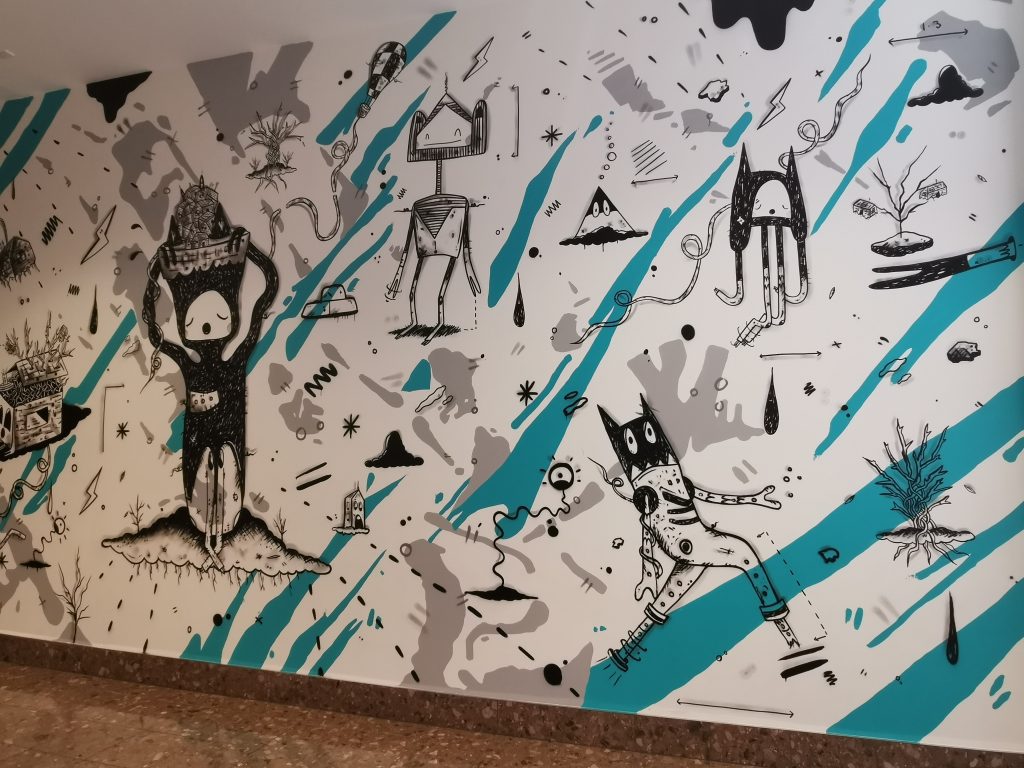
I imagine there’s also times where you are just waiting for the ‘but’…
Totally.
Often there are just so many stakeholders, right? It’s dealing with one person, but before you know it, someone else’s voice is part of that conversation…
You get it from the beginning, generally. If you get a surprise on a job, you just have to deal with it when you get to it. But I try and figure that stuff out straight away, I just put my cards on the table and tell them straight up, and if they don’t like it, then I just politely walk away from it. I don’t get all upset, I just explain that I’ve been doing it for years and cannot twist in that direction, but I always try and help them solve the problem by putting them in the direction of another artist who might be a good fit.
Did it take time to get comfortable with walking away? There must have been times when you just weren’t able to do so, or have you always had that as a kind of philosophical base?
I set that out pretty much from the beginning. There are a couple of jobs that I shouldn’t have done, but I can count them on one hand, so I have stuck to it. It’s easier for me to stick to that anyway because my work is so quirky. It’s not as if I’m painting realism where a client would say: “Well, we want something really specific…” They know what they’re getting and it’s really easy to twist a narrative into my works while keeping my style. But it means that I don’t get as much work as someone who paints more realistic stuff, because when you paint realism and all different kinds of subject matter, it’s way easier to relate to in some form or another, whereas my work is definitely more specific. But I like that, I don’t want everyone to get it.
It’s an interesting trajectory, from the heyday of the early Millennium, when people working in the streets had that very iconographic, stylised approach, to the rise of realism, which is entwined with large-scale muralism. It was a case of technical development, but also the reality of serving a commission…
It is interesting and it is something that I think about a lot. There are so many different angles, but ultimately, I feel like it is going along with human nature and the laziness of society. For example, you paint a portrait of a famous person, that image is so relatable, and so accessible, that it’s never going to be a failure…
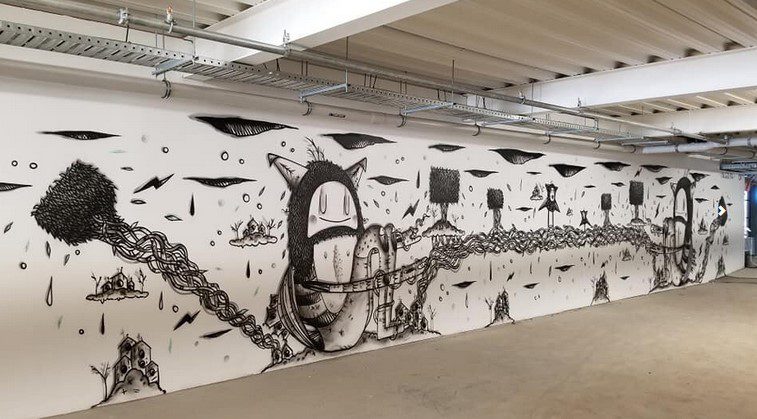
But where do you go from there? How do you ensure it develops as a distinct voice?
For me, the creative process is starting a sketch with an idea, coming up with a story, then having these different, weird, interesting, non-functional, kind-of-human-but-not, characters bring it to life. That’s what it has always been about for me, actually being creative, trying to make something that’s completely new, that has a style and also has a story from the beginning of where I started. It’s like a family growth…
Even the poses and the actions of those characters have come directly from you, they’re not drawing from another source. In that regard, when did your characters crystallize? Did they come out of another form of expression, or was it a conscious thing to sit down and develop a character?
I was in the second year of my degree for graphic design and this guy, Dean, came onto my course. He was heavily involved with graffiti and we just connected straight away. I feel like until then it really wasn’t my path to get into doing street art if not for meeting him. I would have been 18, so it was quite a while ago, but I feel like my pathway into doing that stuff was purely because at that moment in time I met this person. It’s interesting how a time, a place, a moment can change your life.
We are a similar age, so were you aware of the street art scene emerging in the UK around the turn of the Millennium?
Definitely. I was studying graphic design, I was always doing something creative, often on Photoshop or layout programs like QuarkXPress. Skating was a massive thing when I was at college as well. Skate culture really interested me, even though I wasn’t massively into skating myself. I had a lot of mates who were into it and that whole movement and style from skating got me interested in what was happening in that scene, particularly when I met Dean. At the time a lot of artists were blowing up, The London Police were massive, they blew up around ’96 through to ‘99, straight away it drew me in…
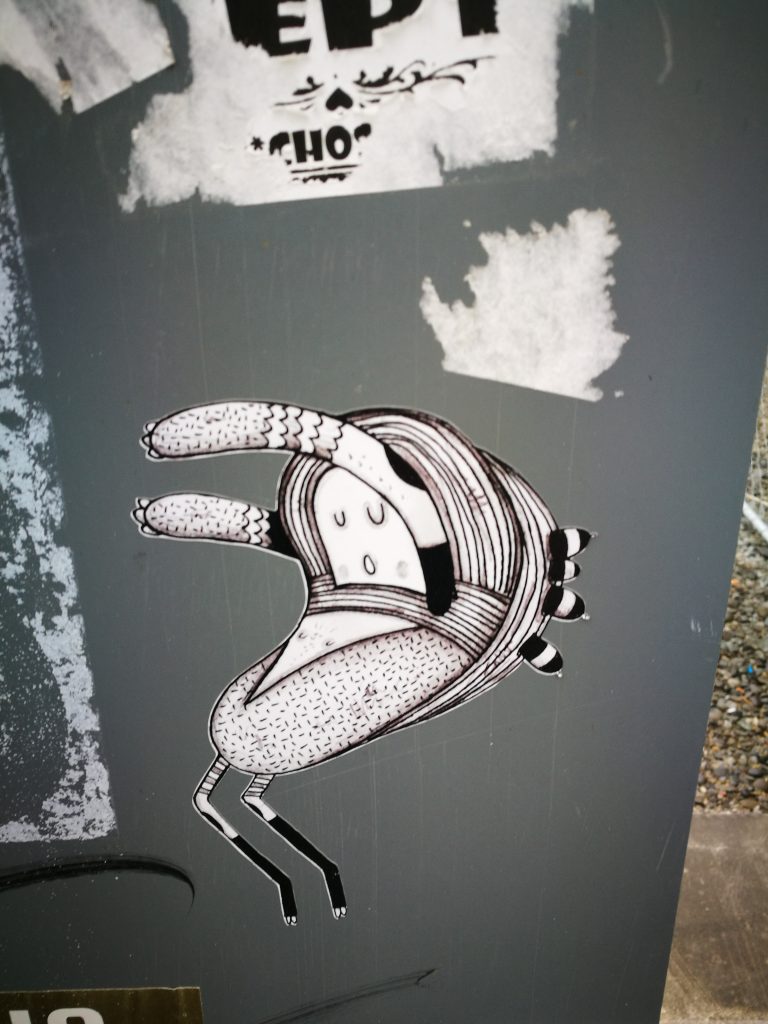
They had that really graphic quality that must have been attractive to someone studying graphic design…
It drew me straight in. At the same time there were so many different artists that were doing it, the thing I loved about it from that character perspective is that you could interact with any type of medium and apply it to a wall. Other artists were important too, Swoon was massive at the time. I was living in Manchester and Swoon had been in town and you could see her amazing pieces, that intricate detail. I loved both of those styles. It was always a case of how I am going to do something for me that incorporates a super graphic style with these other influences…
You were looking to find a balance that resonated with your own interest?
Subliminally, for sure. Whatever form of art you do, whether it is muralism, street art, illustration, sculpture, you always have your peers, you always have someone that influences you in some way or another, whether that’s directly or just something that sits in the back of your head. I always wanted to head towards a kind of sketchy style because when I was at University, I did quite a broad spectrum of study that included printmaking and photography before I specialized in graphic design. So, I did all the printmaking stuff and I loved it, but when I was doing it, it was more just trying to implement the techniques without really knowing how to twist them into what I really wanted to do. So, when I got into doing all this character work, which was super graphic, super bold, I got a little bit, I wouldn’t say bored, but there were a lot of people starting to jump on that direction, so it was like, how can I keep that essence, but drive it in the direction I wanted it to go? I felt like I didn’t have the confidence to make that switch because once you jump into a style, you kind of get stuck and it becomes scary to jump again…
In those early stages, were you making things in the studio exclusively? How long was it before you started getting up in the streets?
It was actually pretty quick. Dean arrived at the beginning of my second year and when we started hanging out, we were basically a couple of stoners. He had a place over in Preston which was close to where we were studying in Blackburn, we would just hang out and have our little sketchbooks. It quickly became something pretty obsessive actually, just constantly sketching. We would go back to his place, get blazed and just start sketching. At that stage he was painting quite a lot, so he would be like, come out with us for a jam. I remember the first time I went out. It was under a train bridge near Preston and it was freezing. It was 3:00 AM in the morning, it was pitch black, we had pre-rolled some joints and we just went out freestyling. As soon as I gave it a go, I was hooked on that rush of just going out and painting. From there it evolved into: how can I take what I do and change it into different things? Paste-ups were massive, I would draw intricate stuff and could literally just turn up and do it…
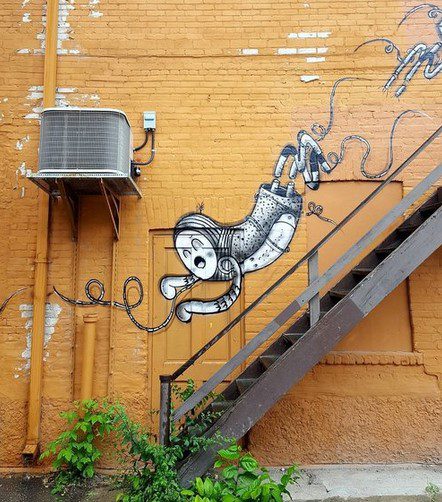
How early did you become aware of how to approach a physical space? Was it part of what you were learning in graphic design as well? A graphic designer has a functional element, right? Designing objects for packaging, things like that. Did you pretty quickly understand that the streets provided an important context?
It is something that comes with time. I think everyone has something in them, an aesthetic that they can produce or do and apply to certain principles, but actually just getting out there and having a go is how you become aware of certain things and how things should sit, so I think you kind of learn those things on the go. I don’t think you can ever plan for that kind of thing, it’s something that builds, and then as you get deeper into it, you start thinking differently. You start thinking, what can I do with this? I definitely couldn’t plan for it anyway, but my expectations were small at the time, I just wanted to go out and be in that moment of painting. The more you paint, and the more you go out and interact with the outside world and the surroundings, things kind of evolve, things happen to you, and you become immersed in that world.
There is a long tradition of characters in graffiti, were you thinking of your characters as accompaniments to graffiti or were they always intended to stand alone?
I think initially that was the thought because I came into it with a graffiti writer, and it works well having the piece and the character. That was definitely the thing for a little bit, that was what was happening. But I wasn’t really tied to that whole situation. I was fresh into it, so it quickly became about how can my characters exist in this world by themselves? I was motivated to get out and try different things. But it’s been a bit of a mixture for me, it started off as a graffiti thing, but it quickly became more, I guess…
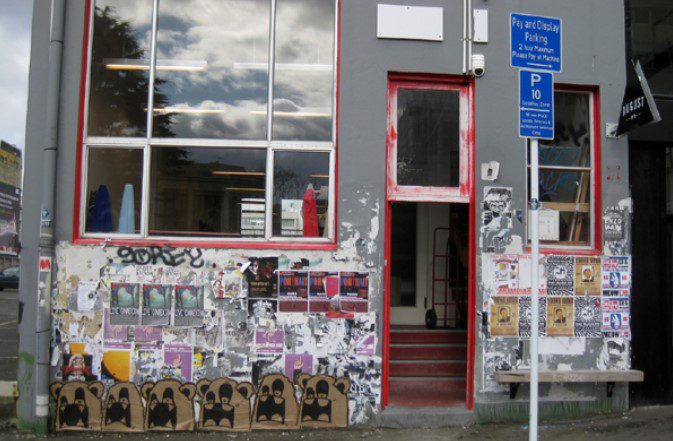
Studying graphic design, I assume you were thinking of that field as a career, when did you start to think what you were doing in the streets could be something more?
It wasn’t for ages, really. It was never a part of my thought process when I got into doing stuff in the streets that this was going to be something that I do as a gig. It was just about going out and painting and enjoying that and it was heavily about being with your mates.
Were you making a full-time living from art or graphic design in the U.K. before coming to Aotearoa?
Definitely not in the UK. I was still working a job and all my art was on the side. I was doing exhibitions and stuff in Manchester, and I was trying to earn some money out of some gallery work, but it was never in my thoughts that this was going to be my full-time job. I came to New Zealand in 2006 with my girlfriend who is a Kiwi, we weren’t actually coming to stay. We came with a six-month work Visa but my partner decided she wanted to go back to study. I was pretty chill, I loved the life here, it’s a whole different world over here compared to growing up in the North of England. You’ve got time here, you can breathe over here, there’s more space, less people. It allowed my mind to slow down a little bit and focus on the direction I wanted to go. So, I jumped into it. I just went for it. In the back of my mind I wanted to make something with art my full-time gig, but the reality at that stage was that I was still working on building sides and all sorts of different things to pay my bills.
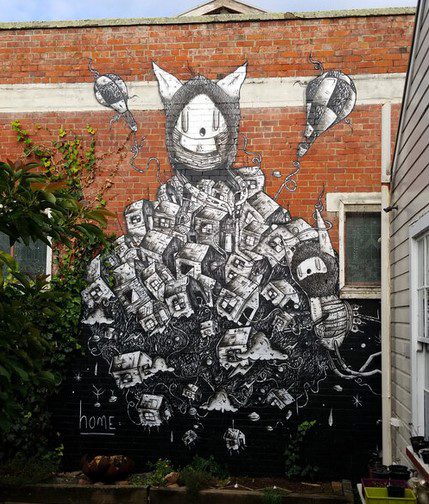
How did you go about building connections here in New Zealand with other artists? Did you consciously reach out to people, or was it a case of diving into the work and letting it occur naturally?
That happened just from diving into it, getting out and painting. I did an exhibition in 2007 at this space in Auckland. It was my first little show, and it was in this semi-immersive kind of exhibition space, a community centre type of space in Devonport. It was very low key, but Cinzah lived around that way, and was connected with them through some projects, and he left a message in the sign-in book, saying: “Where the fuck did this come from? Here’s my email, get in contact and let’s go for a paint…” I became really good mates with Cinzah and it just evolved from that. Flickr was massive at that time as well; everyone was posting stuff. That was how I met Drypnz. We became mates on Flickr. He asked if I would be keen to do an exhibition in Wellington. Eight or nine months later, still not having had a real-life conversation with him, I rented a car, loaded it up, and I drove down to Wellington with all this gear. I got to Wellington and met Drypnz on Cuba Street for the first time. The opening for that show was a big occasion in terms of meeting a lot of creatives, especially around Wellington at that time, PNTR, Editor, Ghostie. I met Kell Sunshine, although she wasn’t painting at the time, the BMD boys…
That’s an impressive list! I was in Wellington just a couple weeks ago and the footprints of so many of those names are still strong, not to mention their work further afield as well…
It was crazy man. It was such a good time to be around. Meeting all these guys that were in the scene and were already cranking on what they were doing, it just made me want to crank it up more. It just kind of all grew from there really, having that inspiration of those guys and girls to just get in on it and get painting, it really pushed me to where I wanted to be.
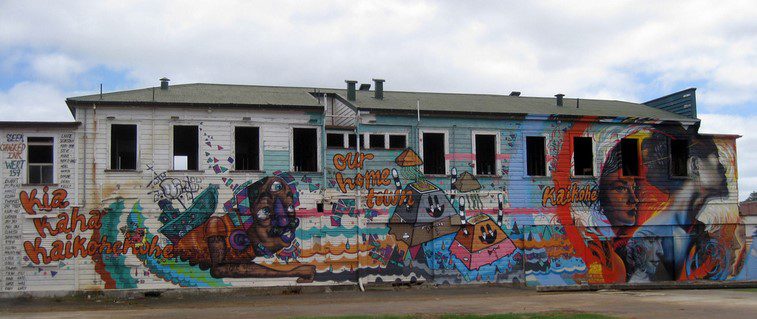
Fast forward a few years and in part through some of those connections you find yourself painting in different countries, that must still be pretty amazing. Do you still think about how you travelled all this way to be here in Aotearoa and now you are travelling the world for festivals like Pangea Seed’s Sea Walls…
Oh man, I don’t know if you call them manic episodes, but you know when things like that happen, it takes you back a little bit. When I got involved with the Sea Walls crew, it was initially to be an artist as a part of the Napier event, and that was a bit of a leg up for me. Cinzah was running that festival, so he got his mates involved. He mentioned he was talking to these guys from Pangea Seed. He had already been to Mexico for a project, and now he was thinking of bringing Sea Walls to New Zealand. He contacted me and asked if I wanted to be in the line-up, and I was like, sure, and things just went from there. I never expect to be part of the Sea Walls crew, that’s for sure, so to end up travelling to different festivals was crazy.
Continued in Part Two…
Follow Cracked Ink on online on Instagram, Facebook and his website

